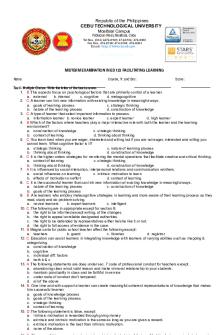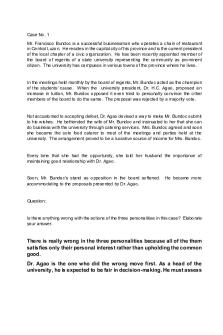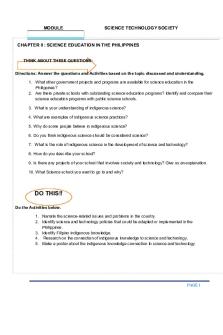Inbound 8141356783122016 63 PDF

| Title | Inbound 8141356783122016 63 |
|---|---|
| Author | Khiana Gyrich Hechanova |
| Course | Bs accountancy |
| Institution | Mindanao State University |
| Pages | 5 |
| File Size | 97.5 KB |
| File Type | |
| Total Downloads | 197 |
| Total Views | 446 |
Summary
Mindanao State University College of Business Administration and Accountancy DEPARTMENT OF ACCOUNTANCY Marawi CityLIABILITIESAccounting 122TRUE OR FALSE. Determine whether the following statements are correct or not. Write A if the statement is correct and write B if not. Final answers should be wri...
Description
Mindanao State University College of Business Administration and Accountancy DEPARTMENT OF ACCOUNTANCY Marawi City
LIABILITIES Accounting 122 TRUE OR FALSE. Determine whether the following statements are correct or not. Write A if the statement is correct and write B if not. Final answers should be written on the answer sheet provided with this questionnaire. Erasures are strictly not allowed. 1. Trade payables and accruals for employee and other operating costs are classified as current liabilities even if they are to be settled more than twelve months after the reporting period. A 2. Liabilities can arise from future transactions or events as in the case of liabilities on purchase commitments. B 3. For a liability to exist, the entity liable must be identified. A 4. An entity shall measure initially a financial liability designated at fair value through profit or loss at fair value plus transaction costs. B 5. An obligation to distribute an entity’s assets as a result of a dividend declared near the end of the current year is classified as part of equity rather than an accounting liability. B 6. Conceptually, all liabilities are measured at present value or discounted amount and subsequently measured at amortized cost. A 7. For a liability to exist, an obligation to pay cash in the future must exist. B 8. The obligation to pay interest on a five-year note payable that was issued the last day of the current year is an example of a liability. B 9. Non-current liabilities are measured at their present value. B 10. For a liability to exist, it is not necessary that the payee to whom the obligation is owed be identified. A 11. A liability which is due to be settled within twelve months after the reporting period is classified as current even if the original term was for a period longer than twelve months and an agreement to refinance or to reschedule payment on a long-term basis is completed before the reporting period. B 12. For a liability to exist, the exact amount of the obligation need not be known. A 13. Non-current liabilities include deferred tax and income tax liabilities. B 14. An example of a liability is the obligation to pay for goods that an entity expects to order from suppliers next year. B 15. Current liabilities shall not be offset against assets that are to be applied to their liquidation. A 16. An entity shall measure initially a financial liability designated at fair value through profit or loss at fair value plus transaction costs. B 17. Short-term obligations are measured, recorded and reported at face amount. A 18. For a liability to be classified as non-current, the entity liable must not have an unconditional right to defer settlement of the liability for at least twelve months after the reporting period. B 19. If certain conditions relating to covenants are breached, the liability shall be classified as current unless the lender has agreed after the reporting period and before the statements are authorized for issue, not to demand payment as a consequence of the breach. B 20. Unasserted claims are never accrued because to do so would require an entity to implicitly admit liability. B 21. A 90-day note, renewable for another 90-day period should be classified in the statement of financial position of an entity as a non-current liability because of note’s renewal option. B 22. Estimated liabilities are either current or non-current in nature. A 23. The signing of a three-year employment contract at a fixed annual salary does not meet the definition of a liability. A 24. Mandatorily redeemable preference shares issued qualify for classification as a liability. A 25. Unearned interest income related to non-interest bearing, long-term note receivable falls under current liabilities. B 26. After initial recognition, an entity shall measure a financial liability either at amortized cost using the effective interest method or at fair value through profit or loss. A 27. When the fair value option of measuring a financial liability is elected, the interest expense on the financial liability is recognized using the nominal interest rate. A 28. Employment taxes that are due to be settled in fifteen month’s time are to be presented under current liabilities. A
Prepared by: Mohammad Muariff S. Balang, CPA, Second Semester, AY 2012-2013
Page | 1
29. When the entity’s normal operating cycle is not clearly identifiable, its duration is assumed to be twelve months. A 30. A note payable with no specified maturity date does not qualify for recognition as a liability. B SHORT PROBLEMS. Compute for the amount/s asked by each problem. Final answers should be written on the answer sheet provided with this questionnaire. Solutions are to be written in a separate sheet of paper to be submitted along with the answer sheet. Erasures are strictly not allowed. PROBLEM 1: On December 31, 2011, the bookkeeper of Glare Company provided the following information: Accounts payable, including deposits and advances from customer of P250,000 P 1,250,000 Notes payable, including note payable to bank on De1,500,00 cember 31, 2013 of P500,000 0 Stock dividend payable 400,000 Credit balances in customer’s accounts 200,000 Serial bonds payable in quarterly installments of P500,000 5,000,000 Accrued interest on bonds payable 150,000 Contested BIR tax assessment – possible obligation 300,000 Unearned rent income 100,000 1. Compute the total current liabilities on December 31, 2011. 4,700,000 PROBLEM 2: Below are independent cases of note payable transactions of three companies. Answer the questions following each case. 2. On October 1, 2010, Pine Company issued a note payable to National Bank in the amount of P1,800,000 bearing interest at 12% and payable in three equal annual principal payments of P600,000. On this date, the bank’s prime rate was 11%. The first interest and principal payment was made on October 1, 2011. On December 31, 2011, what amount should be reported as accrued interest payable? 36,000 3. Mann Company’s liability account balances on June 30, 2010 included a 10% note payable in the amount of P3,600,000. The note is dated October 1, 2009 and payable in three equal annual payments of P1,200,000 plus interest. The first interest and principal payment was made on October 1, 2010. In the June 30, 2012 statement of financial position, what amount relating to this note would be presented under current liabilities? 1,290,000 4. Included in Easy Corporation’s liability account balances on December 31, 2010 was a note payable in the amount of P1,200,000. The note is dated October 1, 2010, bears interest at 15% and is payable in three equal annual payments of P400,000. The first interest and principal payment was made on October 1, 2011. In its 2011 income statement, what amount should Easy Company report as interest expense for this note? 165,000 5. On March 1, 2010, Fine Company borrowed P1,000,000 and signed a two-year note bearing interest at 12% per annum compounded annually. Interest is payable in full at maturity on February 28, 2012. What amount should Fine Company report as a liability for accrued interest on December 31, 2011? 232,000 PROBLEM 3: Easy Company provided the following information on December 31, 2011. Accounts payable – trade P 4,000,000 Notes payable: Trade 3,000,000 Bank loans 2,000,000 Advances from officers 500,000 Bank overdraft 300,000 Contract entered into for the construction of building 5,000,000 Dividends payable 1,000,000 Withholding tax payable 100,000 Mortgage payable 3,800,000 Estimated damages payable by reason of breach of contract 700,000 Income tax payable 800,000 Estimated warranty liability 600,000 Accrued liabilities 900,000 Estimated premium payable 200,000 Claim for increase in wages by employees covered in 3,500,000
Prepared by: Mohammad Muariff S. Balang, CPA, Second Semester, AY 2012-2013
Page | 2
a pending lawsuit 6.
Compute the total current liabilities on December 31, 2011. 14,100,000
PROBLEM 4: The following information about Manchester Company is available on December 31, 2011. Income taxes withheld from employees P 900,000 Cash balance at First State Bank – Account 101 2,500,000 Accounts receivable with credit balance 750,000 Cash overdraft at Second State Bank 1,310,000 Estimated expenses of meeting warranties on merchandise previously sold 500,000 Estimated damages as a result of unsatisfactory performance on a contract 1,500,000 Cash overdraft at First State Bank – Account 102 10,000 Accounts payable 3,000,000 Deferred serial bonds, issued at par and bearing interest at 12%, payable in semi-annual installment of P500,000 due April 1and October 1 of each year , the last bond to be paid October 1, 2017. Interest is also paid semi-annually 5,000,000 Property dividends payable 2,000,000 7.
Compute the total current liabilities on December 31, 2011. 10,110,000
PROBLEM 5: Multiple Company had the following liabilities on December 31, 2011: Accounts payable after deducting debit balances in supplier’s accounts of P100,000 P 500,000 Accrued liabilities 50,000 Note payable – due March 31, 2012 1,000,000 Note payable – due May 1, 2012 800,000 Bonds payable – due December 31, 2013 2,000,000 On March 1, 2012 before the 2011 financial statements were issued, the note payable of P1,000,000 was replaced by an 18-month note for the same amount. The entity is considering similar action on the P800,000 note due on May 1, 2012. The financial statements were issued on March 31, 2012. 8.
Compute the total current liabilities as of December 31, 2011. 2,450,00
PROBLEM 6: Intercon Company is planning to refinance certain short-term obligations on a long-term basis. The entity has a December 31 year-end and the 2011 financial statements will be published on March 15, 2012. On December 31, 2011, before reclassification of shortterm debt, the liabilities are: Current liabilities: Accounts payable P 7,000,000 Note payable – bank 12,000,000 Accrued expenses 4,000,000 Non-current liabilities: Mortgage payable 4,000,000 Note payable – due in 2013 3,000,000 The entity intends to refinance P9,000,000 of the P12,000,000 bank note payable on a longterm basis. Although the entire P12,000,000 is due on June 30, 2012, the bank has informally agreed to extend the maturity date for P6,000,000 to June 30, 2013, if necessary. On January 31, 2012, the entity issued share capital for P4,000,000, net of issue costs and underwriting fees of P500,000. On February 15, 2012, the entity entered into a financing agreement with a financially capable commercial bank, permitting the entity to borrow up to P3,000,000. Borrowings available at the entity’s option on April 1, 2012 will mature five years after the loan date. The entity uses the entire proceeds of the issue of share capital to retire part of the current note payable and now intends to draw down the entire available commitment of the fiveyear debt on April 1, 2012. 9.
Compute the total current liabilities on December 31, 2011. 23,000,000
PROBLEM 7: Canton Cave Company provided the following schedule of liabilities on December 31, 2011: Accounts payable P 6,500,000 Notes payable – bank 8,000,000 Interest payable 150,000 Mortgage note payable – 10% 2,000,000 Bonds payable 4,000,000...
Similar Free PDFs

Inbound 8141356783122016 63
- 5 Pages

Inbound 9062323683313587336
- 8 Pages

Inbound 5823373113343837658
- 7 Pages

Inbound 8992858066865085290
- 35 Pages

Inbound 1325070542858891916
- 28 Pages

Inbound 8120283391829648951
- 6 Pages

Inbound 6016901228306107183
- 9 Pages

Inbound 2127717059
- 2 Pages

Inbound 177382260363055158
- 17 Pages

Inbound 728676790794323547
- 4 Pages

Inbound 8111161337146048105
- 15 Pages

Inbound 320506396223752749
- 13 Pages

Inbound 2570237734164090433
- 30 Pages

Inbound 8069741523876833130
- 53 Pages

Inbound 1326087921954880360
- 18 Pages

Inbound 1582835701478571632
- 47 Pages
Popular Institutions
- Tinajero National High School - Annex
- Politeknik Caltex Riau
- Yokohama City University
- SGT University
- University of Al-Qadisiyah
- Divine Word College of Vigan
- Techniek College Rotterdam
- Universidade de Santiago
- Universiti Teknologi MARA Cawangan Johor Kampus Pasir Gudang
- Poltekkes Kemenkes Yogyakarta
- Baguio City National High School
- Colegio san marcos
- preparatoria uno
- Centro de Bachillerato Tecnológico Industrial y de Servicios No. 107
- Dalian Maritime University
- Quang Trung Secondary School
- Colegio Tecnológico en Informática
- Corporación Regional de Educación Superior
- Grupo CEDVA
- Dar Al Uloom University
- Centro de Estudios Preuniversitarios de la Universidad Nacional de Ingeniería
- 上智大学
- Aakash International School, Nuna Majara
- San Felipe Neri Catholic School
- Kang Chiao International School - New Taipei City
- Misamis Occidental National High School
- Institución Educativa Escuela Normal Juan Ladrilleros
- Kolehiyo ng Pantukan
- Batanes State College
- Instituto Continental
- Sekolah Menengah Kejuruan Kesehatan Kaltara (Tarakan)
- Colegio de La Inmaculada Concepcion - Cebu